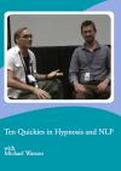
Are you plagued by the voices in your head? Is there a critic that minimizes your successes and beats you up over your failures? Or maybe just a nagging parent or other inner demon that makes you feel bad?
I say "demon" because I think many of my clients have come to me asking for some kind of exorcism.
If you've been following this blog, we've been talking about the idea that it's your thinking that makes you unhappy, or anxious, or fearful, or keeps you from being confident and resourceful and deserving and successful, peaceful HAPPY ... etc.
And I suggested that if you were guilty of this kind of "stinking thinking", that you should just knock it off.
And we've agreed that shutting that voice off may take a little know how ... so here's another trick for you that you can use to put the brakes on that nasty little devil.
It's pretty hard to shut it up, but I wonder if you realize that it MIGHT have some useful feedback for you that you'll want to pay attention to. And what makes you feel bad isn't the words you're hearing ... what gives those words their "sting" is the tone of voice that they come with. So, just let them come, but CHANGE THE TONE!! Change the whole damn voice!
You can listen to Donald Duck, P-P-P-Porky Pig, Betty Boop ... or some sexy and seductive fantasy partner of your choosing.
The video below will tell you how I got control of the voices in MY head .... you might like to try it on for yourself.
(I know some of you have seen this before as it's been "living" on my front page for a while .... but it's about to disappear from there ... remaining here in the archives of Blogville - enjoy!)
I say "demon" because I think many of my clients have come to me asking for some kind of exorcism.
If you've been following this blog, we've been talking about the idea that it's your thinking that makes you unhappy, or anxious, or fearful, or keeps you from being confident and resourceful and deserving and successful, peaceful HAPPY ... etc.
And I suggested that if you were guilty of this kind of "stinking thinking", that you should just knock it off.
And we've agreed that shutting that voice off may take a little know how ... so here's another trick for you that you can use to put the brakes on that nasty little devil.
It's pretty hard to shut it up, but I wonder if you realize that it MIGHT have some useful feedback for you that you'll want to pay attention to. And what makes you feel bad isn't the words you're hearing ... what gives those words their "sting" is the tone of voice that they come with. So, just let them come, but CHANGE THE TONE!! Change the whole damn voice!
You can listen to Donald Duck, P-P-P-Porky Pig, Betty Boop ... or some sexy and seductive fantasy partner of your choosing.
The video below will tell you how I got control of the voices in MY head .... you might like to try it on for yourself.
(I know some of you have seen this before as it's been "living" on my front page for a while .... but it's about to disappear from there ... remaining here in the archives of Blogville - enjoy!)


 RSS Feed
RSS Feed
